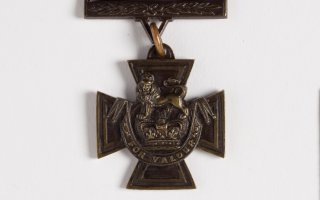The History of the Victoria Cross: Britain's Highest Military Decoration
The award dates back to the Crimean War.
Here's What You Need to Know: This distinguished award has an interesting history.
It is hard to think of the history of Great Britain without considering class and social status, and it was for these reasons that Queen Victoria established the Victoria Cross. Introduced in 1856 to reward acts of valor in the face of the enemy, the medal has been awarded 1,358 times to 1,353 individual recipients, and only 14 medals have been awarded since the end of the Second World War.
The Victoria Cross is Great Britain’s highest military decoration, and it has been awarded to members of the armed forces soldier serving in the British army, as well as those in Commonwealth and British Empire territories. The award itself dates back to the Crimean War. It was during this conflict with Russia where war correspondent William Howard Russell described the acts of bravery and valor committed by British soldiers of all rank and class.
Prior to this war, medals and awards were fairly uncommon with the British armed forces, and there was certainly little in the way of standardized system. Military leaders such as Arthur Wellesley were rewarded with titles, and hence he became the Duke of Wellington, while junior officers were eligible for awards such as the Order of the Bath, or possibly promotion to higher rank. In many cases only those who were under the direct command, and therefore notice of their commanders, received such accolades.
There was a consensus that a new award was needed, and one that would not discriminate against class or rank. Thus on January 29, 1856 Queen Victoria signed a Royal Warrant that officially established the Victoria Cross, and further authorized the award to recognize acts of valor and bravery during the Crimean War. Since then it may be awarded to any person of any rank in any service, or civilians under military command. The recipient is officially presented the award by the British monarch at a ceremony held at Buckingham Palace.
The metal used to make the actual awards comes from gunmetal of two cannons that were captured from the Russian army at the siege of Sevastopol. Some historians dispute this fact and have offered an alternative theory that some VCs are of metal from Chinese guns, not Russia. There is also another theory that the metal of some World War II vintage VCs may have been from another source. Regardless, the spirit of the medal, not the metal, is what matters most.
Collecting the Victoria Cross
Unlike more common awards, such as the German Iron Cross, collecting the Victoria Cross is not for the beginner collectors. These awards seldom come up for sale, and it is unlikely most collectors will ever see one in a shop or militaria show for sale. However, unlike with the American Congressional Medal of Honor, there is no law against selling your award. Sadly many veterans had been forced to sell their VCs to make ends meet after retirement.
British politician and businessman Lord Ashcroft has the largest private collection of VCs, with what is believed to be more than 140. He published a book detailing his collection in November 2006.
Copies and miniatures of the awards are readily available for sale, and even for advanced collectors these are possibly the closest many will get to owning Britain’s highest military decoration.
VC Facts:
*The largest number award for actions on a single day was twenty-four on November 16, 1857 during the Indian Mutiny at the relief of Lucknow.
*The largest number awarded for a single action was eleven for the defense of Rorke’s Drift during the Zulu War on January 22, 1879.
*The largest number awarded for a single conflict was 634 during the First World War.
*Thomas Henry Kavanagh was the first civilian, and only one of five to win the Victoria Cross, for his efforts to sneak out of the city of Lucknow to aid the relieving force outside.
*Corporal Bill Apiata of the Special Air Service of New Zealand is the most recent recipient of the Victoria Cross for New Zealand (July 2, 2007) for aiding a severely wounded comrade while under machine-gun fire in Afghanistan in 2004.
Peter Suciu is a Michigan-based writer who has contributed to more than four dozen magazines, newspapers and websites. He is the author of several books on military headgear including A Gallery of Military Headdress, which is available on Amazon.com.
This article first appeared in October 2020.
Image: Auckland War Memorial Museum

